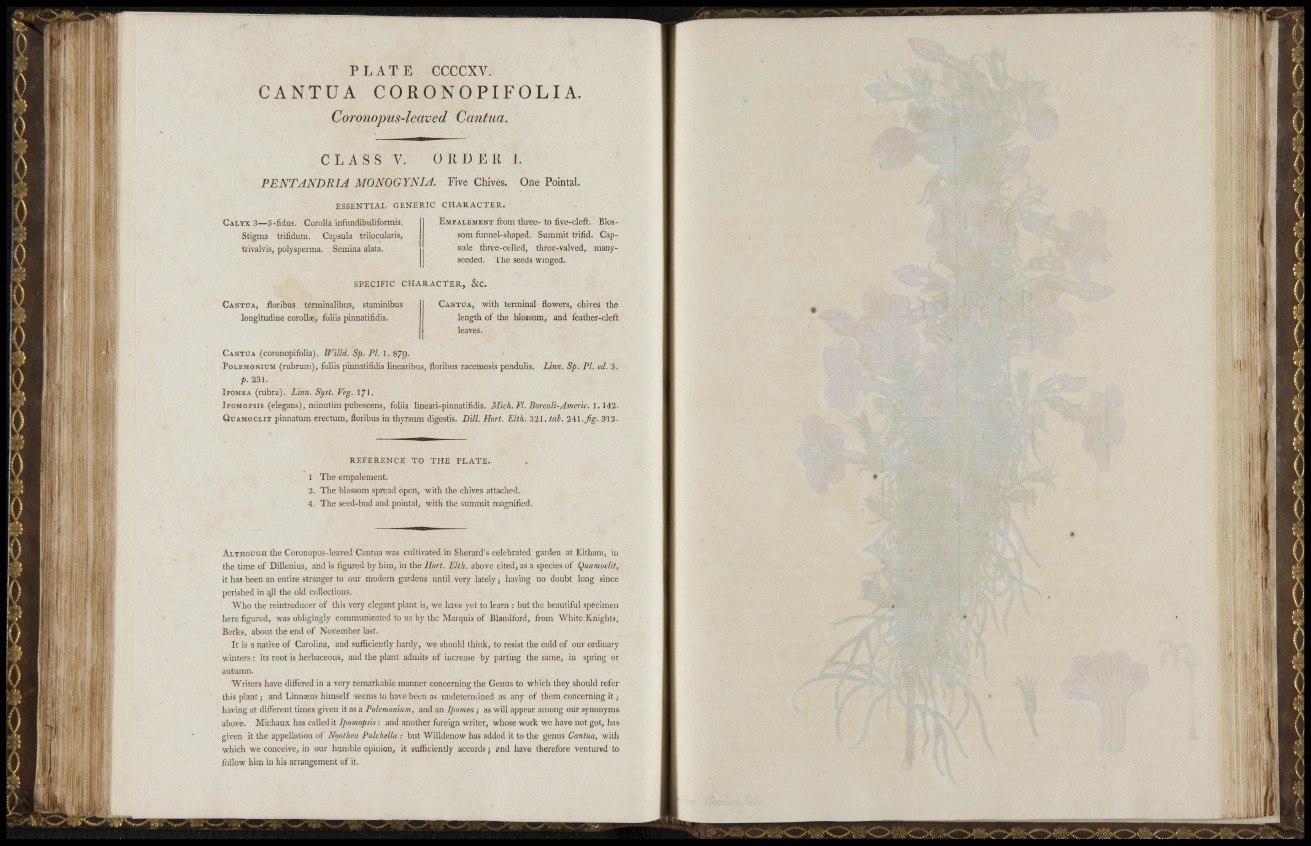
Sif i
I i i y
î'Iyl
i I
.'í :
t r m
If-ÉH,,,
S:''I,
P L A T E CCCCXV.
CANTUA CORONOPIFOLIA.
Coronopus-leaved Cantila.
C L A S S V. ORDER I.
PENTANDRIA MONOGYNIA. Five Chives. One Pointal.
E S S E N T I A I . GENERIC CHARACTER.
CALYX 3—5-fidus. Corolla infiindibuliformis.
Stigma trifidum. Capsula trilocularis,
ti'ivalvis, polysperma. Semina alata.
EMPALEMENT from tliree- to five-cleft. Blossom
funnel-shaped. Summit trifid. Capsule
three-cellcd, three-valved, manyseeded.
The seeds winged.
S P E C I F I C CHARACTER, &C.
CANTUA, floribus terminalibus, staminibus
longitudine corollae, foliis pinnatifidis.
CANTUA, with terminal flowers, chives the
length of the blossom, and feather-cleft
leaves.
CANTUA (coronopifolia). IVilld. Sp. PL I. 879-
POLEMONIUM (rubrum), foliis pinnatifidis linearibus, floribus racemosis pendulis. Linn. Sp. PL cd. 3.
p. 231.
IPOMEA (rubra). Linn. Syst. Feg. 171.
IFOMOPSIS (elegans), minutim pubescens, foliis lineari-pinnatifldis. Mich. FL Boreali-Americ. 1.142.
QUAMOCLIT pinnatum erectum, floribus in thyrsum digestís. DHL Hort. Elth. 321. tab. 2'i\.fig. 3'12.
R E F E R E N C E TO THE PLATE.
1 The empalement.
2. The blossom spread open, with the chives attached.
4. The seed-bud and pointal, with tlie summit magnified.
ALTHOUGH the Corcnopus-leaved Cantua was cultivated in Sherard's celebrated garden at Eltham, in
the time of Dillenius, and is figured by him, in the Ilort. Elth. above cited, as a species of Quamoclit,
it has been an entire stranger to our modern gardens until very lately; having no doubt long since
perished in all the old collections.
Who the reintroducer of this very elegant plant is, we have yet to learn : but tlie beautiful specimen
here figured, was obligingly communicated to us by the Marquis of Blandford, from White Knights,
Berks, about the end of November last.
It is a native of Carolina, and sufficiently hardy, we should think, to resist the cold of our ordinary
winters : its root is herbaceous, and the plant admits of increase by parting the same, in spring or
autumn.
Writers have differed in a very remarkable manner concerning the Genus to wiiich they should refer
this plant; and Linnaeus himself seems to have been as undetermined as any of them concerning it;
having at different times given it as a Polemonium, and an Ipomea; as will appear among our synonymsabove.
Michaux has called it Ipomopsis : and anotlier foreign writer, whose work we have not got, has
given it the appellation of Nvolhca Pulchella : but Willdenow has added it to the genus Cantua, witli
which we conceive, in our hunible opinion, it sufficiently accords; ?nd have therefore ventured to
follow him in his arrangement of it.